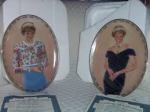Christmas Trees – the custom and traditions

A small tabletop tree with candles stands as a tribute to our German grandfather’s ancestry. A hand sewnSt. Nicholas doll stands beside the tree.
The tradition of putting up and decorating a Christmas tree began in Germany in the 16th century.
Legend has it that Protestant reformer Martin Luther, who was awed by the brilliance of twinkling stars amidst evergreens on a nighttime walk, wired candles to Christmas tree branches to recapture the scene.
The idea of a decorated Christmas tree was slow to gain popularity in Puritan America. Puritans held to a strict sacred observation of Christmas. In fact, in 1659, hanging decorations brought fines for breaking the law against observance of December 25 (other than a church service).
The Puritan legacy diminished with the influx of German and Irish immigrants and Christmas trees became the focal point of those who celebrate Christmas in America.
Thinking about Christmas trees from childhood is sure to stir a bit of nostalgia.
I can remember piling into the family station wagon and driving into the Texas hill country to cut the perfect tree. We’d sing Christmas carols and eat a picnic lunch. Fun times.
I’d stare for hours at the icicles reflecting in the multi-colored bulbs then beg to be in charge of cutting off the lights before bedtime so I could stay up late. I might add that those icicles had to hang single strand over single branches. Daddy was always watching to be sure.
Once I married and we had our own tree, I’d planned to throw the icicles haphazardly on the tree. Somehow, it didn’t look right. Or maybe it was Daddy’s voice echoing in my head.
 Christmas trees continue to play an important role in our holiday decorating.
Christmas trees continue to play an important role in our holiday decorating.
In Houston, we placed multiple trees around our Victorian home. Most were artificial and each tree had its own theme.
For years we’ve collected White House and Texas Capitol ornaments. Those collections hang on gold-branched display trees every year.
With the Rio Grande National Forest as our backyard, we can secure a permit, take a short hike, and have a fresh cut tree whenever we’re ready to decorate.
I do miss all the little helpers I had in years past. Putting gumdrops on the gumdrop tree by myself (a tradition from my Irish grandmother) isn’t the same.
 This year our new four-legged baby, Finnegan MacCool will be helping, which may or may not be a good thing.
This year our new four-legged baby, Finnegan MacCool will be helping, which may or may not be a good thing.
Here’s Finn helping me make a Christmas stocking for the newest family member-our granddaughter’s new husband.
Should be fun time decorating the Christmas tree this year with an Old English sheepdog puppy. At five months everything is a chew toy.
How’s the decorating going at your place? Is a Christmas tree part of your holiday tradition?





